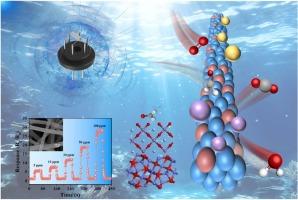LaFeO3/Co3O4 nanofibers with p-p heterojunction for enhanced formaldehyde sensing performance at low temperature
IF 3.7
1区 化学
Q1 CHEMISTRY, ANALYTICAL
引用次数: 0
Abstract
Perovskite semiconductors have been developed rapidly in the field of gas sensors because of their unique structure. In this paper, LaFeO3/Co3O4 composite nanofibers were prepared by uniaxial electrospinning combined with annealing. The results demonstrate that the LaFeO3/Co3O4 composite exhibits a uniform nanofiber structure with a diameter of about 180 nm and a rough and porous surface. The gas-sensing test data that contrasted with pure LaFeO3, the response value of LaFeO3/Co3O4 nanofibers to formaldehyde gas was markedly improved (from 12.65 to 27.82), and the operating temperature was also reduced (100 ℃). In addition, it has excellent response-recovery time and stability. Through mechanism analysis and density functional theory (DFT) studies, the improved performance of the LaFeO3/Co3O4 sensor is attributed to the porous fiber structure, high specific surface area, abundant oxygen vacancy and p-p heterojunction. In addition, the high catalytic activity of Co3O4 promotes surface chemical reactions, accelerates electron transfer, and greatly improves gas-sensing performance. This paper offers an excellent strategy for the design of high-performance LaFeO3-based formaldehyde sensors.

具有p-p异质结的LaFeO3/Co3O4纳米纤维增强了低温甲醛传感性能
钙钛矿半导体以其独特的结构在气体传感器领域得到了迅速的发展。采用单轴静电纺丝与退火相结合的方法制备了LaFeO3/Co3O4复合纳米纤维。结果表明:LaFeO3/Co3O4复合材料具有均匀的纳米纤维结构,直径约为180 nm,表面粗糙多孔;气敏测试数据表明,与纯LaFeO3相比,LaFeO3/Co3O4纳米纤维对甲醛气体的响应值明显提高(从12.65提高到27.82),工作温度也降低(100℃)。此外,它还具有良好的响应恢复时间和稳定性。通过机理分析和密度泛函理论(DFT)研究,LaFeO3/Co3O4传感器性能的提高归因于其多孔纤维结构、高比表面积、丰富的氧空位和p-p异质结。此外,Co3O4的高催化活性促进了表面化学反应,加速了电子转移,大大提高了气敏性能。本文为设计高性能的基于lafeo3的甲醛传感器提供了一种极好的策略。
本文章由计算机程序翻译,如有差异,请以英文原文为准。
求助全文
约1分钟内获得全文
求助全文
来源期刊

Sensors and Actuators B: Chemical
工程技术-电化学
CiteScore
14.60
自引率
11.90%
发文量
1776
审稿时长
3.2 months
期刊介绍:
Sensors & Actuators, B: Chemical is an international journal focused on the research and development of chemical transducers. It covers chemical sensors and biosensors, chemical actuators, and analytical microsystems. The journal is interdisciplinary, aiming to publish original works showcasing substantial advancements beyond the current state of the art in these fields, with practical applicability to solving meaningful analytical problems. Review articles are accepted by invitation from an Editor of the journal.
 求助内容:
求助内容: 应助结果提醒方式:
应助结果提醒方式:


